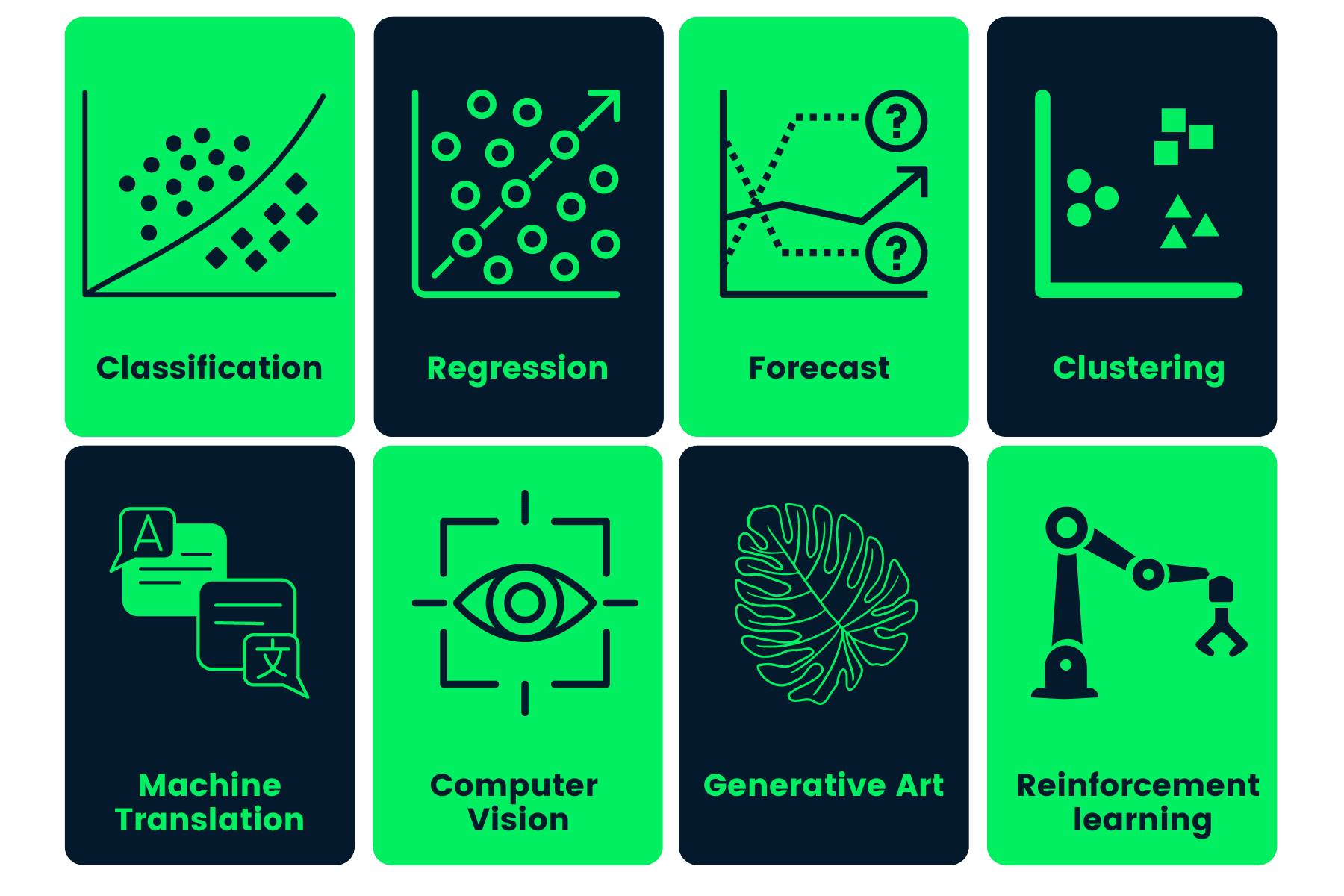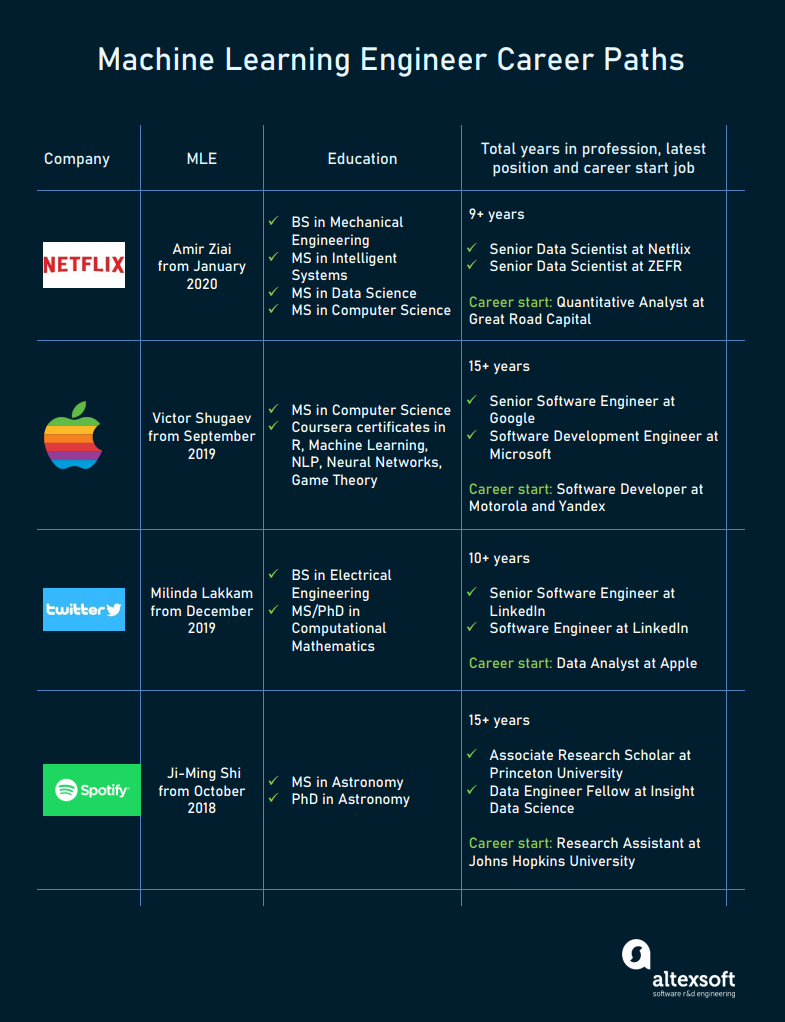All Categories
Featured
Table of Contents
- – The smart Trick of Computational Machine Learn...
- – The 20-Second Trick For Why I Took A Machine L...
- – Fascination About How To Become A Machine Lea...
- – Fascination About Machine Learning Engineer: ...
- – How 7 Best Machine Learning Courses For 2025...
- – Software Engineering In The Age Of Ai - The ...
You possibly know Santiago from his Twitter. On Twitter, every day, he shares a lot of practical points concerning machine knowing. Alexey: Prior to we go into our primary subject of relocating from software application design to maker learning, maybe we can start with your history.
I began as a software program developer. I mosted likely to college, obtained a computer technology level, and I started building software. I think it was 2015 when I made a decision to go with a Master's in computer science. At that time, I had no idea regarding artificial intelligence. I really did not have any rate of interest in it.
I know you've been using the term "transitioning from software design to device understanding". I like the term "including to my capability the artificial intelligence abilities" much more because I think if you're a software application designer, you are already offering a lot of worth. By including artificial intelligence currently, you're enhancing the effect that you can have on the market.
Alexey: This comes back to one of your tweets or perhaps it was from your course when you contrast 2 techniques to learning. In this instance, it was some issue from Kaggle regarding this Titanic dataset, and you just find out how to fix this problem making use of a details device, like decision trees from SciKit Learn.
The smart Trick of Computational Machine Learning For Scientists & Engineers That Nobody is Talking About
You first find out mathematics, or straight algebra, calculus. When you recognize the mathematics, you go to equipment learning theory and you find out the theory.
If I have an electric outlet below that I need replacing, I do not desire to most likely to university, invest four years understanding the math behind electrical power and the physics and all of that, simply to transform an electrical outlet. I prefer to begin with the outlet and discover a YouTube video that helps me go through the trouble.
Poor analogy. But you understand, right? (27:22) Santiago: I really like the concept of beginning with a trouble, trying to toss out what I understand approximately that issue and comprehend why it doesn't work. Then get the tools that I require to address that issue and start excavating deeper and deeper and much deeper from that point on.
That's what I generally recommend. Alexey: Possibly we can speak a little bit regarding finding out resources. You stated in Kaggle there is an intro tutorial, where you can obtain and learn just how to make decision trees. At the beginning, before we began this interview, you mentioned a pair of publications also.
The only requirement for that program is that you recognize a little bit of Python. If you go to my account, the tweet that's going to be on the top, the one that claims "pinned tweet".
The 20-Second Trick For Why I Took A Machine Learning Course As A Software Engineer

Even if you're not a developer, you can start with Python and work your method to even more artificial intelligence. This roadmap is concentrated on Coursera, which is a platform that I actually, truly like. You can examine all of the training courses for complimentary or you can spend for the Coursera subscription to get certificates if you wish to.
That's what I would do. Alexey: This returns to one of your tweets or maybe it was from your training course when you compare two strategies to discovering. One strategy is the issue based method, which you just spoke about. You locate a problem. In this situation, it was some problem from Kaggle about this Titanic dataset, and you just discover exactly how to fix this issue making use of a details device, like decision trees from SciKit Learn.

You first discover mathematics, or straight algebra, calculus. Then when you recognize the mathematics, you go to artificial intelligence concept and you learn the concept. 4 years later, you ultimately come to applications, "Okay, how do I use all these four years of math to resolve this Titanic problem?" ? In the former, you kind of conserve yourself some time, I think.
If I have an electric outlet right here that I require changing, I don't wish to go to university, invest four years comprehending the math behind electrical power and the physics and all of that, just to alter an electrical outlet. I would rather begin with the outlet and locate a YouTube video clip that aids me undergo the issue.
Bad example. Yet you get the idea, right? (27:22) Santiago: I truly like the idea of starting with a trouble, trying to toss out what I know up to that issue and comprehend why it doesn't work. Grab the devices that I need to fix that trouble and start excavating deeper and much deeper and deeper from that point on.
Alexey: Possibly we can talk a bit regarding finding out sources. You discussed in Kaggle there is an introduction tutorial, where you can obtain and discover how to make decision trees.
Fascination About How To Become A Machine Learning Engineer
The only demand for that program is that you recognize a bit of Python. If you're a designer, that's an excellent beginning point. (38:48) Santiago: If you're not a developer, after that I do have a pin on my Twitter account. If you most likely to my profile, the tweet that's mosting likely to get on the top, the one that says "pinned tweet".
Also if you're not a designer, you can start with Python and work your means to even more machine understanding. This roadmap is concentrated on Coursera, which is a system that I really, really like. You can audit all of the courses free of cost or you can pay for the Coursera registration to get certificates if you wish to.
Fascination About Machine Learning Engineer: A Highly Demanded Career ...
To ensure that's what I would do. Alexey: This returns to one of your tweets or perhaps it was from your course when you contrast 2 approaches to learning. One strategy is the problem based technique, which you just spoke about. You locate a problem. In this instance, it was some problem from Kaggle about this Titanic dataset, and you just discover how to fix this issue using a certain device, like decision trees from SciKit Learn.

You initially learn mathematics, or linear algebra, calculus. When you understand the mathematics, you go to device learning theory and you find out the theory.
If I have an electric outlet right here that I need changing, I do not intend to most likely to college, spend 4 years recognizing the math behind electricity and the physics and all of that, just to alter an outlet. I prefer to start with the outlet and discover a YouTube video clip that helps me go through the trouble.
Santiago: I really like the concept of starting with a problem, attempting to throw out what I know up to that issue and comprehend why it doesn't work. Get the devices that I require to resolve that problem and start digging much deeper and deeper and much deeper from that factor on.
Alexey: Perhaps we can talk a little bit regarding learning resources. You pointed out in Kaggle there is an introduction tutorial, where you can get and discover exactly how to make choice trees.
How 7 Best Machine Learning Courses For 2025 (Read This First) can Save You Time, Stress, and Money.
The only need for that course is that you recognize a little of Python. If you're a programmer, that's a fantastic base. (38:48) Santiago: If you're not a designer, then I do have a pin on my Twitter account. If you most likely to my account, the tweet that's going to be on the top, the one that states "pinned tweet".
Also if you're not a developer, you can begin with Python and work your method to more machine learning. This roadmap is concentrated on Coursera, which is a system that I actually, actually like. You can examine all of the programs free of cost or you can spend for the Coursera registration to obtain certifications if you wish to.
Alexey: This comes back to one of your tweets or possibly it was from your training course when you compare 2 methods to discovering. In this instance, it was some problem from Kaggle about this Titanic dataset, and you just find out how to address this problem utilizing a certain device, like choice trees from SciKit Learn.
You initially discover mathematics, or linear algebra, calculus. After that when you understand the math, you go to artificial intelligence theory and you learn the concept. 4 years later on, you lastly come to applications, "Okay, just how do I utilize all these 4 years of mathematics to address this Titanic issue?" Right? So in the former, you sort of save yourself time, I think.
Software Engineering In The Age Of Ai - The Facts
If I have an electric outlet below that I need replacing, I do not desire to go to college, invest 4 years recognizing the mathematics behind electricity and the physics and all of that, simply to transform an outlet. I prefer to begin with the outlet and locate a YouTube video that assists me experience the problem.
Santiago: I really like the idea of starting with a trouble, trying to throw out what I recognize up to that trouble and comprehend why it does not work. Order the devices that I require to solve that problem and start digging deeper and deeper and deeper from that factor on.

To ensure that's what I typically recommend. Alexey: Maybe we can speak a bit about discovering sources. You mentioned in Kaggle there is an intro tutorial, where you can get and discover how to choose trees. At the start, prior to we started this interview, you mentioned a pair of books too.
The only requirement for that program is that you recognize a little bit of Python. If you go to my account, the tweet that's going to be on the top, the one that says "pinned tweet".
Even if you're not a developer, you can start with Python and function your way to even more machine learning. This roadmap is concentrated on Coursera, which is a platform that I actually, actually like. You can audit all of the courses completely free or you can spend for the Coursera membership to get certificates if you want to.
Table of Contents
- – The smart Trick of Computational Machine Learn...
- – The 20-Second Trick For Why I Took A Machine L...
- – Fascination About How To Become A Machine Lea...
- – Fascination About Machine Learning Engineer: ...
- – How 7 Best Machine Learning Courses For 2025...
- – Software Engineering In The Age Of Ai - The ...
Latest Posts
Free Data Science & Machine Learning Interview Preparation Courses
Data Science Vs. Software Engineering Interviews – What’s The Difference?
Why Whiteboarding Interviews Are Important – And How To Ace Them
More
Latest Posts
Free Data Science & Machine Learning Interview Preparation Courses
Data Science Vs. Software Engineering Interviews – What’s The Difference?
Why Whiteboarding Interviews Are Important – And How To Ace Them